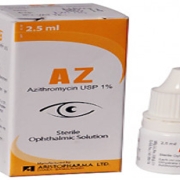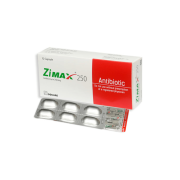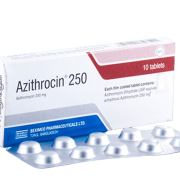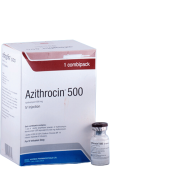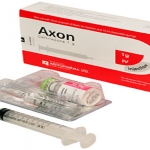AZ (Azithromycin)
Description
Azithromycin is a macrolide antibiotic. It acts by binding to the 50S ribosomal subunit of susceptible microorganisms and interfering with microbial protein synthesis. It is effective against most of the pathogens like-Haemophilus influenzae, Staphylococcus aureus, Streptococcus mitis group & Streptococcus pneumoniee. It is also effective against most isolates of ocular pathogens like Chlamydia pneumoniae, Chlamydia trachomatis, Moraxella catarrhalis, Mycoplasma hominis, Mycoplasma pneumoniae & Neisseria gonorrhoeae.
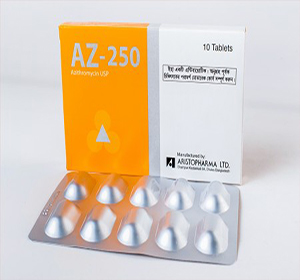
Presentation
AZ-250 Tablet : Each film coated tablet contains Azithromycin Dihydrate USP equivalent to Azithromycin 250 mg.
AZ-500 Tablet : Each film coated tablet contains Azithromycin Dihydrate USP equivalent to Azithromycin 500 mg.
AZ Taste Masked Powder for Suspension : After reconstitution each 5 ml contains Azithromycin Dihydrate USP equivalent to Azithromycin 200 mg.
Indications
AZ is indicated in lower respiratory tract infections including bronchitis and pneumonia, otitis media and in upper respiratory tract infections including sinusitis and pharyngitis/tonsillitis, skin and soft tissue infections, mild to moderate typhoid due to multiple-antibacterial resistant organisms, cholera in children & adult and sexually transmitted diseases both in men and women. Azithromycin is also indicated for the treatment of uncomplicated genital infections due to Chlamydia trachomatis and urethritis and cervicitis due to Chlamydia trachomatis and Neisseria gonorrhoea.
Dosage & Administration
AZ Tablet & Taste Masked Powder for Suspension may be taken with or without food.
Adult: For sexually transmitted disease caused by Chlamydia trachomatis the dose is 1 g as a single close. For all other indications, the total dose is 1.5 g which should be given as 500 mg daily for 3 days or initially, 500 mg as a single doses followed by a 250 mg single daily dose for the next 4 days. For typhoid fever, the dose is 500 mg once daily for 14 days.
Elderly: Normal adult dose is recommended.
Children > 6 months: The usual dose is 10 mg/kg body weight as a single daily dose for three days: for body weight 15-25 kg, 200 mg or 5 ml/day for 3 days: body weight 26-35 kg, 300 mg or 7.5 ml/day for 3 days: body weight 36-45 kg, 400 mg or 10 mI/day for 3 days. For typhoid fever 10 mg/kg body weight once daily for 7 days or 20 mg/kg body weight once daily for 5 days.
Children < 6 months: Not recommended.
Contrainidications
AZ is contraindicatd in patients with known hypersensitivity to Azithromycin, erythromycin or any of the macrolide antibiotics.
Warning & Precautions
It is indicated for topical ophthalmic use only and should not be administered systemically, injected subconjunctivally or introduced directly into the anterior chamber of the eye.
Use in pregnancy:
There are no adequate and well-controlled studies in pregnant women. Thus, it should be used during pregnancy only if clearly needed.
Use in lactation:
It is not known whether Azithromycin is excreted in human milk. Caution should be exercised when Azithromycin ophthalmic solution is administered during lactation.
Pediatric use:
The safety and effectiveness of Azithromycin ophthalmic solution in pediatric patients below 1 year of age have not been established. But in a clinical study it was found that Azithromycin 1% Ophthalmic Solution may be given to neonates for the treatment of ophthalmia neonatorum.
Side effects
AZ is well tolerated with a low incidence of side effects. Majority of the side effects are mild to moderate in nature and of gastro-intestinal in origin with nausea, abdominal discomfort, vomiting, flatulence and diarrhoea. Allergic reactions such as rash have occurred and there have also been rare reports of serious hypersensitivity reactions. Reversible elevations in liver transaminase have been seen with a frequency similar to the comparative macrolides and penicillins used in clinical trials.
Drug interaction
Antacids: in patients receiving Azithromycin and antacid. Azithromycin should be taken at least 1 hour before or 2 hours after antacid. Cyclosporin & Digoxin: Macrolides interfere with the metabolism of cyclosporin & digoxin. Ergot derivatives: Because of the theoretical possibility of ergotism, Azithromycin and ergot derivatives should not be coadministered. Terfenadine: As with other macrolides. Azithromycin should be administered with caution in combination with terfenadine.
Overdose: Adverse events experienced in higher than recommended doses were similar to those seen at normal doses. The typical symptoms of an overdose with macrolide antibiotics include reversible loss of hearing, severe nausea, vomiting and diarrhoea. In the event of overdose, the administration of medicinal charcoal and general symptomatic treatment and supportive measures are indicated.
Use in special groups
Use in Pregnancy : Pregnancy category B.
Use in Lactation : Caution should be exercised when Azithromycin is administered to a nursing mother.
Drug Interactions : Antacids: in patients receiving Azithromycin and antacid, Azithromycin should be taken at least 1 hour before or 2 hours after antacid. Cyclosporin & Digoxin: Macrolides interfere with the metabolism of cyclosporin & digoxin. Ergot derivatives: Because of the theoretical possibility of ergotism, Azithromycin and ergot derivatives should not be coadministered. Terfenadine: As with other macrolides, Azithromycin should be administered with caution in combination with terfenadine.
Packing
AZ-250 Tablet: Box containing 10 tablets in alu-alu blister pack.
AZ-500 Tablet: Box containing 12 tablets in alu-alu blister pack.
AZ Taste Masked Powder For Suspension: Each bottle contains 20/35/50 ml Taste Masked Powder for Suspension.


